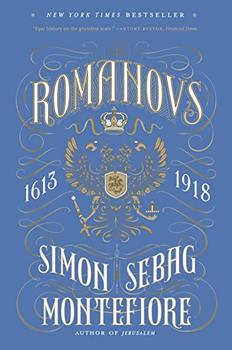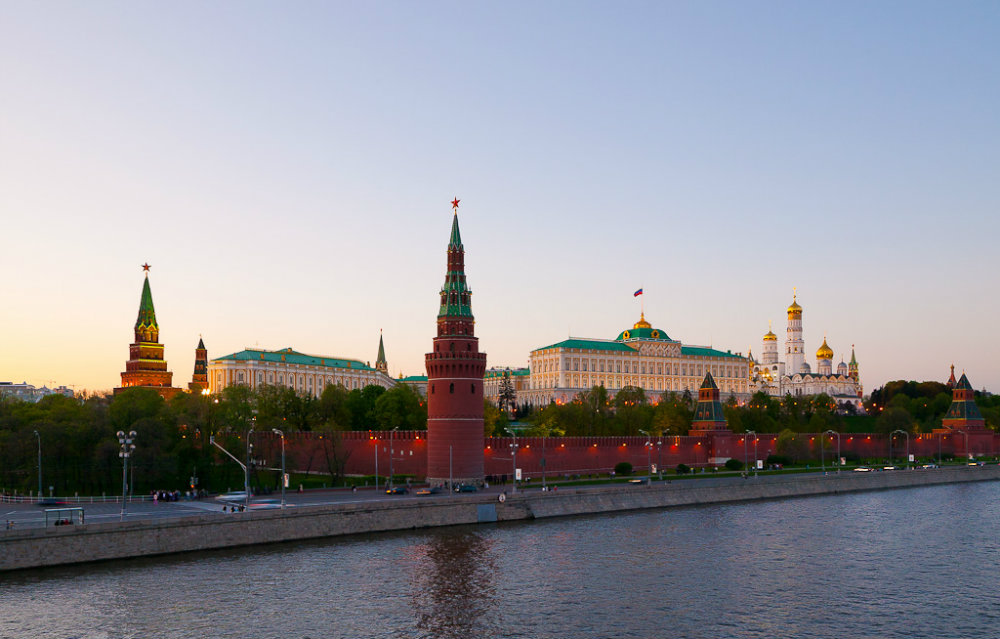Summary | Excerpt | Reviews | Beyond the Book | Read-Alikes | Genres & Themes | Author Bio

Critics' Opinion:
Readers' Opinion:
First Published:
May 2016, 784 pages
Paperback:
May 2017, 784 pages
 Book Reviewed by:
Book Reviewed by:
Kim Kovacs
Buy This Book
This article relates to The Romanovs
"Kremlin" is the Russian word for a castle or fortified complex, and many Eastern European cities, including Novgorod, Smolensk and Kiev have one. Most people however, associate the Kremlin with the seat of the Russian government in Moscow.
The site of the Moscow Kremlin, a hill near where the Neglina and Moskva Rivers converge, shows evidence of human occupation as early as 500 BCE and some speculate it was inhabited centuries before that. In 1147 Yuri Dolgorukiy, the Grand Duke of Kiev, built a wooden fort in this location; it became both the start of the city of Moscow and the precursor of today's Kremlin. The city grew in size and importance (in spite of being raided by the Mongols in 1208 and again in 1237) and eventually became the headquarters of the Russian Orthodox Church. Dmitri Donskoy, Prince of Moscow from 1359-1389, had the city's wooden walls replaced with limestone. By the end of the 14th century, the population had expanded well beyond the fortifications into the surrounding countryside.

The warlord Ivan the Great, Grand Prince of Moscow and Grand Prince of All Rus', defeated the Mongols and became the tsar. During his rule (1462-1505) the buildings that once comprised all of Moscow started to metamorphose into what we think of today as the Kremlin. The fortress became the center of both Russia's government and its religion, and was designated a "world apart," a walled-off complex at the very center of Moscow. Ivan hired architects from Renaissance Italy to construct grand cathedrals and other government buildings, replacing the much less impressive wooden structures with beautiful stone edifices, some of which are still in use today. Included in this overhaul were the Cathedral of the Assumption, the Cathedral of Annunciation and the Archangel, the Cathedral of the Dormition (where coronations were held), and the still-standing Ivan the Great Bell Tower.
Ivan the Great's grandson, known as Ivan the Terrible, was Grand Prince of Moscow from 1533-1547 and the first Tsar of All Russia (1547-1584). He renovated a few of the structures and added a palace and a cathedral for his sons. The Kremlin was further expanded by the first Romanov ruler, Tsar Michael I (with construction completed by his son and heir Alexis). An 11-domed Upper Savior Cathedral, Armorial Gate, the Palace of Patriarch Nikon and the Amusement Palace were built. Also erected during this era was the Terem Palace, which became the royal residence and is now the official home of the President of Russia, currently Vladimir Putin.
Peter the Great, Tsar of All Russia from 1682-1721 and Emperor of All Russia from 1721-1725, was nearly assassinated in the Kremlin and as a result hated it and moved his court to the newly built St. Petersburg. Coronations were still held in Moscow, but the buildings deteriorated from neglect over the ensuing decades until the reign of Catherine the Great (1762-1796). Catherine returned the government to the Kremlin and began a massive renovation campaign on her ascension to the throne. She ordered the construction of a grand palace, and to make room for it several cathedrals and palaces were demolished. Unfortunately, work on her palace was halted due to lack of funds.
French forces occupied the Kremlin in September and October 1812, and Napoleon ordered its destruction when his army was compelled to retreat from Moscow. The Kremlin Arsenal, parts of the wall and several of the watchtowers along the wall were blown up; fires damaged other buildings. The destruction wasn't anywhere near as complete as Napoleon wished, however, as it was raining too hard to keep the fuses lit.
Subsequent rulers put their mark on the complex, tearing down some parts, adding others and remodeling still others to suit their tastes and current architectural trends. Very little was changed between 1851 and the Russian Revolution of 1917. While it remained the new government's central office, Stalin had the imperial golden eagles on the Kremlin's towers replaced with the Soviet star, and many of the 16th-century buildings were demolished to make room for a military school.
The Kremlin was closed to tourists until 1955, when Khrushchev re-opened it, designating sections of it as a museum in 1961. It houses innumerable artifacts of inestimable worth, including Russia's State Regalia (akin to England's Crown Jewels), collections of arms and armor, artwork, photographs and manuscripts. It was designated a World Heritage Site in 1990 – one of the first sites to obtain that distinction. Its current director Elena Gargarina (cosmonaut Yuri Gagarin's daughter) continues working toward restoration of the buildings contained in the complex; her current project is the refurbishment of the interiors of the Grand Palace, which were extensively altered during Stalin's regime.
Picture of the Kremlin by Alexander Gusev
Filed under Places, Cultures & Identities
![]() This "beyond the book article" relates to The Romanovs. It originally ran in July 2016 and has been updated for the
May 2017 paperback edition.
Go to magazine.
This "beyond the book article" relates to The Romanovs. It originally ran in July 2016 and has been updated for the
May 2017 paperback edition.
Go to magazine.





The House on Biscayne Bay
by Chanel Cleeton
As death stalks a gothic mansion in Miami, the lives of two women intertwine as the past and present collide.

The Flower Sisters
by Michelle Collins Anderson
From the new Fannie Flagg of the Ozarks, a richly-woven story of family, forgiveness, and reinvention.

The Funeral Cryer by Wenyan Lu
Debut novelist Wenyan Lu brings us this witty yet profound story about one woman's midlife reawakening in contemporary rural China.
Your guide toexceptional books
BookBrowse seeks out and recommends the best in contemporary fiction and nonfiction—books that not only engage and entertain but also deepen our understanding of ourselves and the world around us.